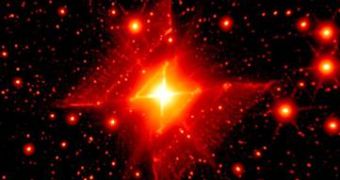In nature, symmetry is the sign of beauty. Even humans find symmetrical faces to be the most beautiful. If this were to be applied to stars, then astronomers may have found the newest supermodel of the skies.
Named Red Square (no connection with the famous Moscow central square), the bipolar nebula is the most symmetrical ever photographed. It was captured using Adaptive Optics, a system capable of taking images of space without atmospheric distortion or blurring.
A nebula is an interstellar cloud of gas, dust and plasma where stars can both emerge and die.
University of Sydney school of physics senior lecturer Peter Tuthill and his American colleague, James Lloyd, of Cornell University, made the discovery while conducting a four-year project in the US researching the birth of stars.
By combining extremely high-resolution, near-infrared images of the star - taken by the Mt Palomar Hale telescope in California and the Keck-2 telescope in Hawaii - they realized that MWC 922 was the core of a nebula, an object formed by gas, dust and a central star.
Seen in the infrared, the nebula resembles a giant, glowing red box in the sky, with a bright white inner core. A dying star called MWC 922 is located at the system's center and spewing its innards from opposite poles into space.
The star is located roughly 5000 light-years away. A light-year is 9.46 trillion kilometers. "It should have been discovered before," Sydney University astrophysicist Peter Tuthill said, "It's so nearly square that people probably mistook it for an aberration of the telescope."
This spectacular light show is the death of a star, and After MWC 922 ejects most of its material into space, it will contract into a dense stellar corpse known as a white dwarf, shrouded by clouds of its own remains.
The Red Square nebula is the most symmetrical object ever imaged, having an almost perfect square shape.

 14 DAY TRIAL //
14 DAY TRIAL //